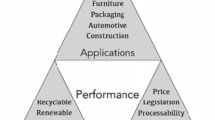Abstract
The use of natural fibres instead of man made fibres, as reinforcements in thermoplastics, gives interesting alternatives for production of low cost and ecologically friendly composites. In this work different commercially available semi-finished natural fibre mat reinforced thermoplastics (NMT) composites have been studied. Mechanical properties and microstructure of different NMT composites were investigated and compared to conventional GMT (glass fibre mat reinforced thermoplastic) composites and pure polypropylene (PP). The study included also NMT composites manufacturing processing parameters as processing temperatures and pressure during compression moulding. The results showed that NMT composites have a high stiffness compared to pure polymer and the NMT with a high fibre content (50% by weight) showed even better stiffness than the GMT. The GMT composites had superior strength and impact properties compared to the NMT which might be due to the relatively low strength of the natural fibres but also to poor adhesion to the PP matrix. The NMT materials showed a large dependence on direction and are therefore believed to have more fibres oriented in one direction. The stronger direction (0°) of the NMT was in some cases as much as 45% better than the 90° direction.
Similar content being viewed by others
References
Fölster, T. and Michaeli, W., 'Flax-a Renewable Source of Reinforcing Fibre for Plastics', Kunststoffe German Plastics 83(9), 1993, 687–691.
Mieck, K.-P., Nechwatal, A., and Knobelsdorf, C., 'Potential Applications of Natural Fibre in Composite Materials', Internat.Textile Reports 75(11), 1994, 892–898.
Mieck, K.-P., Lützkendorf, R., and Reussmann, T., 'Needle-Punched Hybrid Nonwovens of Flax and PP Fibres-Textile Semiproducts for Manufacturing of Fibre Composites', Polymer Comp. 17(6), 1996, 873–878.
Heijenrath, R. and Peijs, T., 'Natural-Fibre-Mat-Reinforced Thermoplastic Composites Based on Flax Fibres and Polypropylene', Adv.Comp.Letter 5(3), 1996, 81–85.
Hornsby, P. R., Hinrichen, E., and Taverdi, K., 'Preparation and Properties of Polypropylene Composites Reinforced with Wheat and Flax Straw Fibres', J.Mater.Sci. 32(4), 1997, 1009–1015.
Sanadi, A. R., Cauldfield, D. F., and Rowell, R. M., 'Reinforcing Polypropylene with Natural Fibres', Plastic Engin. 4, 1994, 27–28.
Oksman, K. and Lindberg, H., 'Interaction between Wood and Synthetic Polymers', Holzforschung 49, 1995, 249–254.
Oksman, K., 'Improved Interaction between Wood and Synthetic Polymers in Wood/Polymer Composites', Wood Sci.Technol. 30, 1996, 197–205.
Bledzki, A. K., Reihmane, S., and Gassan, J., 'Properties and Modification Methods for Vegetable Fibers for Natural Fiber Composites', J.Appl.Polymer Sci. 59, 1996, 1329–1336.
Author information
Authors and Affiliations
Rights and permissions
About this article
Cite this article
Oksman, K. Mechanical Properties of Natural Fibre Mat Reinforced Thermoplastic. Applied Composite Materials 7, 403–414 (2000). https://doi.org/10.1023/A:1026546426764
Issue Date:
DOI: https://doi.org/10.1023/A:1026546426764




